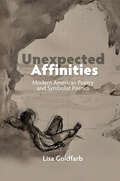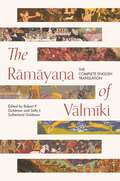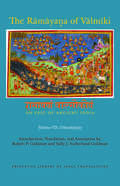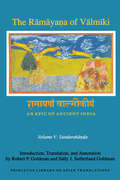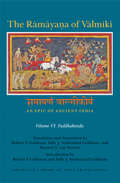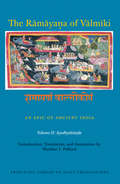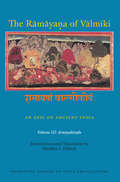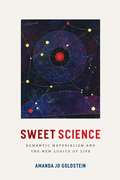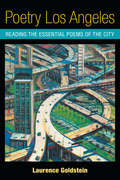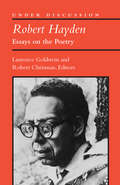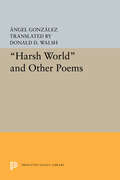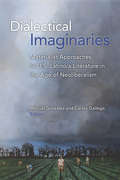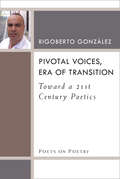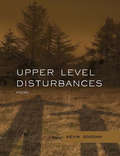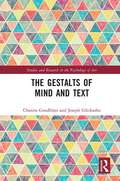- Table View
- List View
Unexpected Affinities: Modern American Poetry and Symbolist Poetics
by Lisa GoldfarbThe book studies the impact of Stevensian and Valeryan poetics, and symbolist poetics more broadly, on a range of Anglo-American poets in untypical fashion. Pairing poets who are not usually studied in their relation to one another reveals mutuality and dissimilitude. Chapter I looks at Stevens and Valery from the vantage point of the senses as opposed to the more usual lens of their similar cerebral or philosophical temperaments. Although critics have largely and justifiably seen Stevens and Eliot in oppositional terms (Stevens proclaims them dead opposites), Lisa Goldfarb asks what happens when we look at them from the vantage point of their mutual interest in creating a musical poetics. Auden is principally known for his distaste for the symbolists and their magical poetics, yet he reserves special praise for Valery and considers him as his poetic mentor; Chapter III studies their poetics side-by-side. With Stevens and Audens mutual appreciation of Valery as a starting point, Chapter IV turns to a closer comparative study of Auden and Stevens, two poets who have traditionally been seen as operating in distinct poetic spheres. While Elizabeth Bishop famously eludes categorization in terms of poetic school or affiliation, a fifth chapter addresses her poetic music in relation to French symbolist poetics, one of the many poetic schools she admired. A sixth and final chapter examines Stevens musical legacy, in large part derived from the symbolists, and addresses the work of a range of modern and contemporary poets, with a final section devoted to the work of contemporary poet, Susan Howe.
Unexpected Affinities: Modern American Poetry and Symbolist Poetics
by Lisa GoldfarbThe book studies the impact of Stevensian and Valeryan poetics, and symbolist poetics more broadly, on a range of Anglo-American poets in untypical fashion. Pairing poets who are not usually studied in their relation to one another reveals mutuality and dissimilitude. Chapter I looks at Stevens and Valery from the vantage point of the senses as opposed to the more usual lens of their similar cerebral or philosophical temperaments. Although critics have largely and justifiably seen Stevens and Eliot in oppositional terms (Stevens proclaims them dead opposites), Lisa Goldfarb asks what happens when we look at them from the vantage point of their mutual interest in creating a musical poetics. Auden is principally known for his distaste for the symbolists and their magical poetics, yet he reserves special praise for Valery and considers him as his poetic mentor; Chapter III studies their poetics side-by-side. With Stevens and Audens mutual appreciation of Valery as a starting point, Chapter IV turns to a closer comparative study of Auden and Stevens, two poets who have traditionally been seen as operating in distinct poetic spheres. While Elizabeth Bishop famously eludes categorization in terms of poetic school or affiliation, a fifth chapter addresses her poetic music in relation to French symbolist poetics, one of the many poetic schools she admired. A sixth and final chapter examines Stevens musical legacy, in large part derived from the symbolists, and addresses the work of a range of modern and contemporary poets, with a final section devoted to the work of contemporary poet, Susan Howe.
The Rāmāyaṇa of Vālmīki: The Complete English Translation (Princeton Library of Asian Translations #157)
by Robert P. Goldman Sally J. GoldmanThe definitive English translation of the classic Sanskrit epic poem—now available in a one-volume paperbackThe Rāmāyaṇa of Vālmīki, the monumental Sanskrit epic of the life of Rama, ideal man and incarnation of the great god Visnu, has profoundly affected the literature, art, religions, and cultures of South and Southeast Asia from antiquity to the present. Filled with thrilling battles, flying monkeys, and ten-headed demons, the work, composed almost 3,000 years ago, recounts Prince Rama’s exile and his odyssey to recover his abducted wife, Sita, and establish a utopian kingdom. Now, the definitive English translation of the critical edition of this classic is available in a single volume.Based on the authoritative seven-volume translation edited by Robert Goldman and Sally Sutherland Goldman, this volume presents the unabridged translated text in contemporary English, revised and reformatted into paragraph form. The book includes a new introduction providing important historical and literary contexts, as well as a glossary, pronunciation guide, and index. Ideal for students and general readers, this edition of the Rāmāyaṇa of Vālmīki introduces an extraordinary work of world literature to a new generation of readers.
The Rāmāyaṇa of Vālmīki: The Complete English Translation (Princeton Library of Asian Translations #157)
by Robert P. Goldman Sally J. GoldmanThe definitive English translation of the classic Sanskrit epic poem—now available in a one-volume paperbackThe Rāmāyaṇa of Vālmīki, the monumental Sanskrit epic of the life of Rama, ideal man and incarnation of the great god Visnu, has profoundly affected the literature, art, religions, and cultures of South and Southeast Asia from antiquity to the present. Filled with thrilling battles, flying monkeys, and ten-headed demons, the work, composed almost 3,000 years ago, recounts Prince Rama’s exile and his odyssey to recover his abducted wife, Sita, and establish a utopian kingdom. Now, the definitive English translation of the critical edition of this classic is available in a single volume.Based on the authoritative seven-volume translation edited by Robert Goldman and Sally Sutherland Goldman, this volume presents the unabridged translated text in contemporary English, revised and reformatted into paragraph form. The book includes a new introduction providing important historical and literary contexts, as well as a glossary, pronunciation guide, and index. Ideal for students and general readers, this edition of the Rāmāyaṇa of Vālmīki introduces an extraordinary work of world literature to a new generation of readers.
The Rāmāyaṇa of Vālmīki: Uttarakāṇḍa
by Robert P. Goldman Sally Sutherland GoldmanThe seventh and final book of the monumental Rāmāyaṇa of Vālmīki, the Uttarakāṇḍa, brings the epic saga to a close with an account of the dramatic events of King Rāma's millennia-long reign. It opens with a colorful history of the demonic race of the rākṣasas and the violent career of Rāma’s villainous foe Rāvaṇa, and later recounts Rāma’s grateful discharge of his allies in the great war at Lankā as well as his romantic reunion with his wife Sītā. But dark clouds gather as Rāma, confronted by scandal over Sītā’s time in captivity under the lustful Rāvaṇa, makes the agonizing decision to banish his beloved wife, now pregnant. As Rāma continues as king, marvelous tales and events unfurl, illustrating the benefits of righteous rule and the perils that await monarchs who fail to address the needs of their subjects.The Uttarakāṇḍa has long served as a point of social and religious controversy largely for its accounts of the banishment of Sītā, as well as of Rāma’s killing of a low-caste ascetic. The translators’ introduction provides a full discussion of these issues and the complex reception history of the Uttarakāṇḍa. This translation of the critical edition also includes exhaustive notes and a comprehensive bibliography.
The Rāmāyaṇa of Vālmīki: Sundarakāṇḍa
by Robert P. Goldman Sally Sutherland GoldmanThe fifth and most popular book of the Ramayana of Valmiki, the Sundarakanda, recounts the adventures of the monkey hero Hanuman in leaping across the ocean to the island citadel of Lanka. Once there, he scours the city for the abducted Princess Siti. The poet vividly describes the opulence of the court of the demon king, Ravana, the beauty of his harem, and the hideous deformity of Sita's wardresses. After witnessing Sita's stern rejection of Ravana's blandishments, Hanuman reveals himself to the princess and restores her hope of rescue. The great monkey then wreaks havoc on the royal park and fights a series of hair-raising battles with Ravana's generals. Permitting himself to be captured by the warrior Indrajit, Hanuman is led into the presence of Ravana, whom he admonishes for his lechery. His tail is set ablaze, but he escapes his bonds and leaping from rooftop to rooftop, sets fire to the city. Taking leave of Sita, Hanuman once more leaps the ocean to rejoin his monkey companions. This is the fifth volume translated from the critical edition of the Valmiki Ramayana. It contains an extensive introduction, exhaustive notes, and a comprehensive bibliography.
The Rāmāyaṇa of Vālmīki: Yuddhakāṇḍa
by Robert P. Goldman Sally Sutherland Goldman Barend A. van NootenThe sixth book of the Ramayana of Valmiki, the Yuddhakanda, recounts the final dramatic war between the forces of good led by the exiled prince Rama, and the forces of evil commanded by the arch demon Ravana. The hero Rama's primary purpose in the battle is to rescue the abducted princess Sita and destroy the demon king. However, the confrontation also marks the turning point for the divine mission of the Ramavatara, the incarnation of Lord Visnu as a human prince, who will restore righteousness to a world on the brink of chaos. The book ends with the gods' revelation to Rama of his true divine nature, his emotional reunion with his beloved wife, his long-delayed consecration as king of Kosala, and his restoration of a utopian age. The Yuddhakanda contains some of the most extraordinary events and larger-than-life characters to be found anywhere in world literature. This sixth volume in the critical edition and translation of the Valmiki Ramayana includes an extensive introduction, exhaustive notes, and a comprehensive bibliography.
The Rāmāyaṇa of Vālmīki: Ayodhyakāṇḍa
by Robert P. Goldman Sheldon I. PollockThis is the second volume of a translation of India's most beloved and influential epic saga, the monumental Rāmāyaṇa of Vālmīki. Of the seven sections of this great Sanskrit masterpiece, the Ayodhyakāṇḍa is the most human, and it remains one of the best introductions to the social and political values of traditional India. This readable translation is accompanied by commentary that elucidates the various problems of the text—philological, aesthetic, and cultural. The annotations make extensive use of the numerous commentaries on the Rāmāyaṇa composed in medieval India. The substantial introduction supplies a historical context for the poem and a critical reading that explores its literary and ideological components.
The Rāmāyaṇa of Vālmīki: Aranyakāṇḍa
by Robert P. Goldman Sheldon I. PollockThis is the third volume of a planned seven-volume translation of India's most beloved and influential epic tale--the Ramayana of Valmiki. This third volume carries forward the narrative by following the exiled hero Rama, his wife, and his brother on their wanderings. The book contains the narrative center of the epic, the abduction of Sita by the demon king Ravana. It provides a profound meditation on the paradox of the hero as both human and divine.The present translation seeks to provide a readable and trustworthy English version of the poem. It is accompanied by a full commentary elucidating the philological, aesthetic, and cultural problems of the text. Extensive use is made in the annotations of the numerous commentaries on the Ramayana. The substantial introduction to this volume aims to supply a historical context for an appreciation of the poem and a critical reading exploring the ideological components of the work.The volumes of this work will present the entire Ramayana, translated for the first time on the basis of the critical edition (Oriental Institute, Baroda).
Sweet Science: Romantic Materialism and the New Logics of Life
by Amanda Jo GoldsteinToday we do not expect poems to carry scientifically valid information. But it was not always so. In Sweet Science, Amanda Jo Goldstein returns to the beginnings of the division of labor between literature and science to recover a tradition of Romantic life writing for which poetry was a privileged technique of empirical inquiry. Goldstein puts apparently literary projects, such as William Blake’s poetry of embryogenesis, Goethe’s journals On Morphology, and Percy Shelley’s “poetry of life,” back into conversation with the openly poetic life sciences of Erasmus Darwin, J. G. Herder, Jean-Baptiste Lamarck, and Étienne Geoffroy Saint-Hilaire. Such poetic sciences, Goldstein argues, share in reviving Lucretius’s De rerum natura to advance a view of biological life as neither self-organized nor autonomous, but rather dependent on the collaborative and symbolic processes that give it viable and recognizable form. They summon De rerum natura for a logic of life resistant to the vitalist stress on self-authorizing power and to make a monumental case for poetry’s role in the perception and communication of empirical realities. The first dedicated study of this mortal and materialist dimension of Romantic biopoetics, Sweet Science opens a through-line between Enlightenment materialisms of nature and Marx’s coming historical materialism.
Sweet Science: Romantic Materialism and the New Logics of Life
by Amanda Jo GoldsteinToday we do not expect poems to carry scientifically valid information. But it was not always so. In Sweet Science, Amanda Jo Goldstein returns to the beginnings of the division of labor between literature and science to recover a tradition of Romantic life writing for which poetry was a privileged technique of empirical inquiry. Goldstein puts apparently literary projects, such as William Blake’s poetry of embryogenesis, Goethe’s journals On Morphology, and Percy Shelley’s “poetry of life,” back into conversation with the openly poetic life sciences of Erasmus Darwin, J. G. Herder, Jean-Baptiste Lamarck, and Étienne Geoffroy Saint-Hilaire. Such poetic sciences, Goldstein argues, share in reviving Lucretius’s De rerum natura to advance a view of biological life as neither self-organized nor autonomous, but rather dependent on the collaborative and symbolic processes that give it viable and recognizable form. They summon De rerum natura for a logic of life resistant to the vitalist stress on self-authorizing power and to make a monumental case for poetry’s role in the perception and communication of empirical realities. The first dedicated study of this mortal and materialist dimension of Romantic biopoetics, Sweet Science opens a through-line between Enlightenment materialisms of nature and Marx’s coming historical materialism.
Sweet Science: Romantic Materialism and the New Logics of Life
by Amanda Jo GoldsteinToday we do not expect poems to carry scientifically valid information. But it was not always so. In Sweet Science, Amanda Jo Goldstein returns to the beginnings of the division of labor between literature and science to recover a tradition of Romantic life writing for which poetry was a privileged technique of empirical inquiry. Goldstein puts apparently literary projects, such as William Blake’s poetry of embryogenesis, Goethe’s journals On Morphology, and Percy Shelley’s “poetry of life,” back into conversation with the openly poetic life sciences of Erasmus Darwin, J. G. Herder, Jean-Baptiste Lamarck, and Étienne Geoffroy Saint-Hilaire. Such poetic sciences, Goldstein argues, share in reviving Lucretius’s De rerum natura to advance a view of biological life as neither self-organized nor autonomous, but rather dependent on the collaborative and symbolic processes that give it viable and recognizable form. They summon De rerum natura for a logic of life resistant to the vitalist stress on self-authorizing power and to make a monumental case for poetry’s role in the perception and communication of empirical realities. The first dedicated study of this mortal and materialist dimension of Romantic biopoetics, Sweet Science opens a through-line between Enlightenment materialisms of nature and Marx’s coming historical materialism.
Sweet Science: Romantic Materialism and the New Logics of Life
by Amanda Jo GoldsteinToday we do not expect poems to carry scientifically valid information. But it was not always so. In Sweet Science, Amanda Jo Goldstein returns to the beginnings of the division of labor between literature and science to recover a tradition of Romantic life writing for which poetry was a privileged technique of empirical inquiry. Goldstein puts apparently literary projects, such as William Blake’s poetry of embryogenesis, Goethe’s journals On Morphology, and Percy Shelley’s “poetry of life,” back into conversation with the openly poetic life sciences of Erasmus Darwin, J. G. Herder, Jean-Baptiste Lamarck, and Étienne Geoffroy Saint-Hilaire. Such poetic sciences, Goldstein argues, share in reviving Lucretius’s De rerum natura to advance a view of biological life as neither self-organized nor autonomous, but rather dependent on the collaborative and symbolic processes that give it viable and recognizable form. They summon De rerum natura for a logic of life resistant to the vitalist stress on self-authorizing power and to make a monumental case for poetry’s role in the perception and communication of empirical realities. The first dedicated study of this mortal and materialist dimension of Romantic biopoetics, Sweet Science opens a through-line between Enlightenment materialisms of nature and Marx’s coming historical materialism.
Sweet Science: Romantic Materialism and the New Logics of Life
by Amanda Jo GoldsteinToday we do not expect poems to carry scientifically valid information. But it was not always so. In Sweet Science, Amanda Jo Goldstein returns to the beginnings of the division of labor between literature and science to recover a tradition of Romantic life writing for which poetry was a privileged technique of empirical inquiry. Goldstein puts apparently literary projects, such as William Blake’s poetry of embryogenesis, Goethe’s journals On Morphology, and Percy Shelley’s “poetry of life,” back into conversation with the openly poetic life sciences of Erasmus Darwin, J. G. Herder, Jean-Baptiste Lamarck, and Étienne Geoffroy Saint-Hilaire. Such poetic sciences, Goldstein argues, share in reviving Lucretius’s De rerum natura to advance a view of biological life as neither self-organized nor autonomous, but rather dependent on the collaborative and symbolic processes that give it viable and recognizable form. They summon De rerum natura for a logic of life resistant to the vitalist stress on self-authorizing power and to make a monumental case for poetry’s role in the perception and communication of empirical realities. The first dedicated study of this mortal and materialist dimension of Romantic biopoetics, Sweet Science opens a through-line between Enlightenment materialisms of nature and Marx’s coming historical materialism.
Sweet Science: Romantic Materialism and the New Logics of Life
by Amanda Jo GoldsteinToday we do not expect poems to carry scientifically valid information. But it was not always so. In Sweet Science, Amanda Jo Goldstein returns to the beginnings of the division of labor between literature and science to recover a tradition of Romantic life writing for which poetry was a privileged technique of empirical inquiry. Goldstein puts apparently literary projects, such as William Blake’s poetry of embryogenesis, Goethe’s journals On Morphology, and Percy Shelley’s “poetry of life,” back into conversation with the openly poetic life sciences of Erasmus Darwin, J. G. Herder, Jean-Baptiste Lamarck, and Étienne Geoffroy Saint-Hilaire. Such poetic sciences, Goldstein argues, share in reviving Lucretius’s De rerum natura to advance a view of biological life as neither self-organized nor autonomous, but rather dependent on the collaborative and symbolic processes that give it viable and recognizable form. They summon De rerum natura for a logic of life resistant to the vitalist stress on self-authorizing power and to make a monumental case for poetry’s role in the perception and communication of empirical realities. The first dedicated study of this mortal and materialist dimension of Romantic biopoetics, Sweet Science opens a through-line between Enlightenment materialisms of nature and Marx’s coming historical materialism.
Hebrew Poems from Spain (The Littman Library of Jewish Civilization)
by David GoldsteinThe years 950-1200 are often called the Golden Age of the Jews in Spain. During this period, the Jews reached a peak of achievement in all aspects of their life—political, spiritual, and cultural. They produced great works of literature and philosophy; their poetry represents a peak of literary achievement unparalleled in Hebrew until the twentieth century. The poets of the Golden Age forged the language of the Hebrew Bible into a magnificent instrument for the expression of every facet of their experience--love and friendship, war and exile, philosophy and prayer. Their poems reflect their overarching consciousness of Israel’s relationship with God and their deep concern with the fate of the Jewish people in exile. Not until modern times did Hebrew poetic genius flourish again with such freedom and with such intensity. This volume conveys in modern English something of the greatness of that literature while as far as possible preserving the poetic values and beauty of the Hebrew original. Brief notes on the work of each of the thirteen poets represented put the poems in their proper perspective and do much to elucidate their meaning. The poets included are Dunash Halevi ben Labrat, Joseph ibn Abithur, Isaac ibn Kalpon, Samuel Hanagid, Solomon ibn Gabirol, Isaac ibn Gi’at, Moses ibn Ezra, Judah Halevi, Abraham ibn Ezra, Joseph ibn Zabara, Judah Alharizi, Shem Tob ben Palquera, and Todros ben Judah Abulafia. ‘Remains the only anthology in English devoted entirely to the Golden Age with selections from all the major and some minor poets presented in verse translations. The book is a gift to the academic world and to all readers interested in the literary achievements of the Jews.’ From the Foreword by Raymond Scheindlin
Poetry Los Angeles: Reading the Essential Poems of the City
by Laurence GoldsteinIs there such a thing as Los Angeles poetry? How do we assess a poem about a city as elusive of identity as Los Angeles? What features do poems about this unique urban landscape of diverse peoples and terrains have in common? Poetry Los Angeles is the first book to gather and analyze poems about sites as different as Hollywood, Santa Monica and Venice beaches, the freeways, downtown, South Central and East L.A. Laurence Goldstein presents original commentary on six decades of poets who have contributed to the iconography and poetics of Los Angeles literature, including Elizabeth Alexander, Jimmy Santiago Baca, Dorothy Barresi, Victoria Chang, Wanda Coleman, Dana Gioia, Joy Harjo, James Harms, Robert Hass, Eloise Klein Healy, Garrett Hongo, Suzanne Lummis, Paul Monette, Harryette Mullen, Carol Muske-Dukes, Frederick Seidel, Gary Soto, Timothy Steele, Diane Wakoski, Derek Walcott, and Charles Harper Webb. Forty poems are reproduced in their entirety. One chapter is devoted to Charles Bukowski, the celebrity face of the city’s poetry. Other chapters discuss the ways that poets explore “Interiors” and “Exteriors” throughout the cityscape. Goldstein also provides ample connections to the novels, films, art, and politics of Southern California. In clear prose, Poetry Los Angeles examines the strategies by which poets make significant places meaningful and memorable to readers of every region of the U.S. and elsewhere.
Robert Hayden: Essays on the Poetry (Under Discussion)
by Laurence Goldstein Robert ChrismanThis collection of essays by leading critics and poets charts Robert Hayden’s growing reputation as a major writer of some of the twentieth century’s most important poems on African-American themes, including the famed “Middle Passage” and “Frederick Douglass.” The essays illuminate the themes and techniques that established Hayden as a modernist writer with affinities to T. S. Eliot, Federico Garcia Lorca, and W. B. Yeats, as well as to traditions of African-American writings that include such figures as Countee Cullen and Langston Hughes. Robert Hayden: Essays on the Poetry is the first and only book to collect significant essays on this distinguished poet. Covering sixty years of commentary, book reviews, essays, and Hayden’s own published materials, this volume is an invaluable contribution to our understanding of the poet’s vision of experience, artistry, and influence. The book includes forty different works that examine the life and poetry of Hayden, the first African-American to serve as Consultant in Poetry to the Library of Congress (the post now called Poet Laureate) and to receive the Grand Prix de la Poesie at the First World Festival of Negro Arts, Dakar, Senegal, in 1966.
Harsh World and Other Poems
by Angel Gonzalez Donald D. WalshAlthough seven volumes of his poetry are available in Spanish, the work of Ángel González has not been widely translated into English. This bilingual edition, introduced by the poet, presents selections from Palabra sobre palabra (Word upon Word), his definitive collection. Included are poems from Grado elemental (Elementary Grade), which won the Antonio Machado Prize for Poetry. Born in Oviedo, Spain in 1925, Ángel González published his first book in 1956 to immediate acclaim. His poetry is characterized by striking imagery and deeply personal statement that is often sad and sardonic. Of his work González writes, "'Experience,' 'reality', and 'preciseness of expression' are probably...the boundaries that limit the space, on a horizontal plane, in which my poetic intentions move. Upon this plane, trying to add another dimension, I attempt to erect my creative and imaginative possibilities....In some of these poems, written and published in Spain, the result of a determined desire to bear witness will have to be sought not in what the words say but in what they imply, in the spaces of shadow, of silence of anger, or of helplessness that they discover or uncover."Originally published in 1977.The Princeton Legacy Library uses the latest print-on-demand technology to again make available previously out-of-print books from the distinguished backlist of Princeton University Press. These editions preserve the original texts of these important books while presenting them in durable paperback and hardcover editions. The goal of the Princeton Legacy Library is to vastly increase access to the rich scholarly heritage found in the thousands of books published by Princeton University Press since its founding in 1905.
Dialectical Imaginaries: Materialist Approaches to U.S. Latino/a Literature in the Age of Neoliberalism (Class : Culture)
by Marcial Gonzalez Carlos GallegoDialectical Imaginaries brings together essays that analyze the effects of class conflict and capitalist ideology on contemporary works of U.S. Latino/a literature. The editors argue that recent global events have compelled contemporary scholars to reexamine traditional interpretive models that center on identity politics and an ethics of multiculturalism. The volume seeks to demonstrate that materialist methodologies have a greater critical reach than other methods, and that Latino/a literary criticism should be more attuned to interpretive approaches that draw on Marxism and other globalizing social theories. The contributors analyze a wide range of literary works in fiction, poetry, drama, and memoir by writers including Rudolfo Anaya, Gloria Anzaldúa, Daniel Borzutzky, Angie Cruz, Sergio de la Pava, Mónica de la Torre, Sergio Elizondo, Juan Felipe Herrera, Rolando Hinojosa, Quiara Alegría Hudes, Lin-Manuel Miranda, Óscar Martínez, Cherríe Moraga, Urayoán Noel, Emma Pérez, Pedro Pietri, Miguel Piñero, Ernesto Quiñónez, Ronald Ruiz, Hector Tobar, Rodrigo Toscano, Alfredo Véa, Helena María Viramontes, and others.
Pivotal Voices, Era of Transition: Toward a 21st Century Poetics (Poets On Poetry)
by Rigoberto GonzalezPivotal Voices, Era of Transition gathers Rigoberto González’s most important essays and book reviews, many of which consider the work of emerging poets whose identities and political positions are transforming what readers expect from contemporary poetry. A number of these voices represent intersectional communities, such as queer writers of color like Natalie Díaz, Danez Smith, Ocean Vuong, and Eduardo C. Corral, and many writers, such as Carmen Giménez Smith and David Tomás Martínez, have deep connections to their Latino communities. Collectively, these writers are enriching American poetry to reflect a more diverse, panoramic, and socially conscious literary landscape. Also featured are essays on the poets’ literary ancestors—including Juan Felipe Herrera, Alurista, and Francisco X. Alarcón—and speeches that address the need to leverage poetry as agency. This book fills a glaring gap in existing poetry scholarship by focusing exclusively on writers of color, and particularly on Latino poetry. González makes important observations about the relevance, urgency, and exquisite craft of the work coming from writers who represent marginalized communities. His insightful connections between the Latino, African American, Asian American, and Native American literatures persuasively position them as a collective movement critiquing, challenging, and reorienting the direction of American poetry with their nuanced and politicized verse. González’s inclusive vision covers a wide landscape of writers, opening literary doors for sexual and ethnic minorities.
Upper Level Disturbances (Mountain West Poetry Series)
by Kevin GoodanMountain West Poetry Series Published by the Center for Literary Publishing at Colorado State University
The Gestalts of Mind and Text (Studies and Research in the Psychology of Art)
by Chanita Goodblatt Joseph GlicksohnThe Gestalts of Mind and Text bridges literary studies and cognitive psychology to provide a unique contribution to the field of Cognitive Literary Studies. The book presents an investigation of metaphor in poetic texts, adopting and developing empirical methods used by Gestalt Psychology, while integrating concepts informed by Gestalt Psychology. The title indicates an intellectual tradition, to be termed the Gestalt of the Mind, that begins with the Würzburg School of Psychology and its subsequent development into Gestalt Psychology, which provides a rich heritage for the field of Cognitive Literary Studies. The title further indicates an intellectual and creative tradition, to be termed the Gestalt of the Text, applied to various literary schools (Medieval, Early Modern, Modernist). Finally, the Gestalt-Interaction Theory of Metaphor delineates the potentialities for different types of readings of poetic metaphor. This book further makes three significant contributions: the first is the focus on the empirical investigation of metaphor in poetic texts; the second is the integration of the aspects of problem-solving, bidirectionality of metaphor, embodied cognition and the grotesque, in analyzing poetic texts and verbal protocols; and the third is the focus on various literary traditions, spanning languages and periods. The goal of this book is to present an interdisciplinary study of the Gestalts of Mind and Text. This will be of interest to a varied audience, including cognitive psychologists, literary scholars, researchers in aesthetics, scholars of metaphor and those with an interest in intellectual history.
The Gestalts of Mind and Text (Studies and Research in the Psychology of Art)
by Chanita Goodblatt Joseph GlicksohnThe Gestalts of Mind and Text bridges literary studies and cognitive psychology to provide a unique contribution to the field of Cognitive Literary Studies. The book presents an investigation of metaphor in poetic texts, adopting and developing empirical methods used by Gestalt Psychology, while integrating concepts informed by Gestalt Psychology. The title indicates an intellectual tradition, to be termed the Gestalt of the Mind, that begins with the Würzburg School of Psychology and its subsequent development into Gestalt Psychology, which provides a rich heritage for the field of Cognitive Literary Studies. The title further indicates an intellectual and creative tradition, to be termed the Gestalt of the Text, applied to various literary schools (Medieval, Early Modern, Modernist). Finally, the Gestalt-Interaction Theory of Metaphor delineates the potentialities for different types of readings of poetic metaphor. This book further makes three significant contributions: the first is the focus on the empirical investigation of metaphor in poetic texts; the second is the integration of the aspects of problem-solving, bidirectionality of metaphor, embodied cognition and the grotesque, in analyzing poetic texts and verbal protocols; and the third is the focus on various literary traditions, spanning languages and periods. The goal of this book is to present an interdisciplinary study of the Gestalts of Mind and Text. This will be of interest to a varied audience, including cognitive psychologists, literary scholars, researchers in aesthetics, scholars of metaphor and those with an interest in intellectual history.
